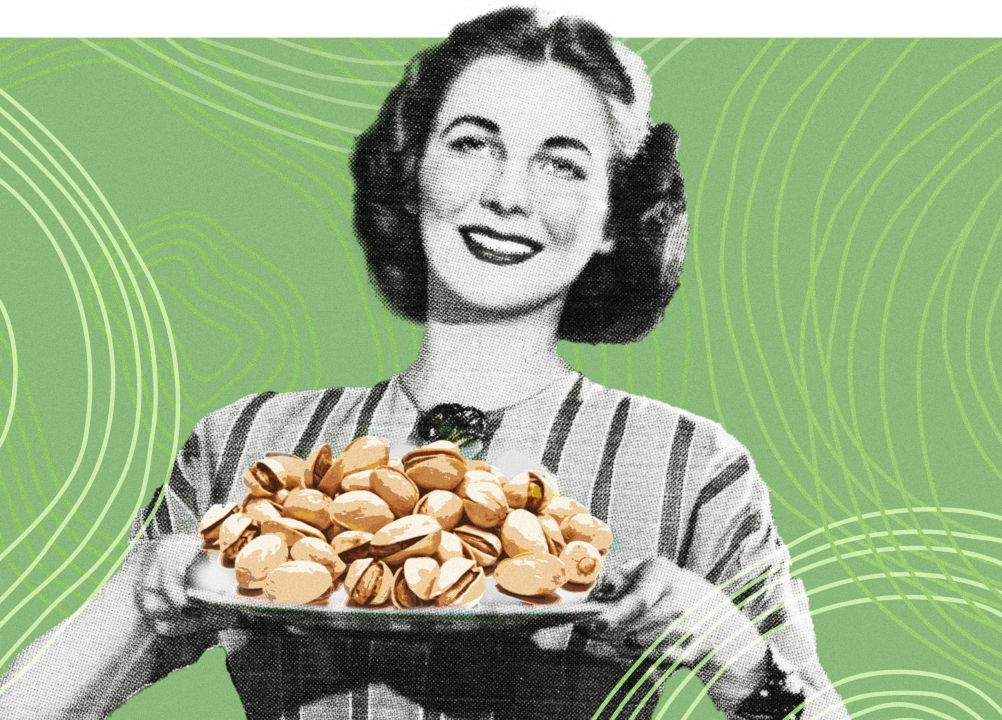You could be forgiven for thinking you’d walked into Oz: in the past couple of years, the whole world has gone green. Pale green, to be precise. Suddenly, pistachio is everywhere: it’s in our pastries, our chocolate, our coffees, our puddings, and even showing up in perfumes, paint charts, scented candles and on our fashion runways.
Where has this sudden lust for pistachio come from? In one way, pistachios are old news: they’re an ancient crop that has grown in the Middle East and been used as an ingredient in Middle Eastern and Mediterranean cookery for as long as can be remembered. They’re even referred to in Genesis: ‘Take some of the choice fruits of the land in your bags, and carry them down as a present to the man: a little balm and a little honey, gum, resin, pistachio nuts and almonds.’ So why are they suddenly the ingredient of the moment?
Both Marks & Spencer and Starbucks have added pistachio-flavoured coffees to their 2025 menus (joining Caffé Nero who had introduced a similar offering already). M&S have also launched miniature pistachio-rolled eggs – and shoppers aren’t waiting around until Easter, already hailing them the ‘product of the year’. Other, bigger pistachio chocolate eggs line the supermarket aisles, jostling to boast the greenest possible packaging. Aldi and Lidl have both produced pistachio cremes for their luxury lines; Waitrose has its own pistachio tiramisu. John Lewis has named pistachio its ‘colour of the season’ and is soon to launch its Leckford tableware range in the shade. The colour has also been enjoying a moment in the literal spotlight on red carpets and on our clothing rails.
And then there’s the ‘Dubai chocolate bar,’ a pistachio-filled creation that went viral on TikTok and sent the internet mad. Made by Dubai chocolatier Fix Dessert, it’s a thick milk chocolate bar filled with a mixture of pistachio cream, tahini and toasted knafeh, which is a shredded phyllo pastry. It was just one of a new line of products with different flavours, but the pistachio version – ‘Can’t get knafeh of it’ – was the one which captured the world’s imagination. It’s stonkingly big at 450g, but even so, it was retailing in Dubai for the equivalent of £15. Really, the bar is only available in Dubai, but if you know where to look you can get hold of it in the UK – as long as you’re prepared to part with £35 for the privilege. Unsurprisingly, dupes immediately abounded, along with a host of videos on TikTok and beyond telling the home cook how to make their own; even big brands such as Lindt jumped on the bandwagon and created their own version (which sold out straight away too).
Pistachios have always signalled luxury: they are one of the more expensive nuts, and it helps that the pistachio is the supermodel of the nut world. Shelled pistachios are green, with little wispy skins that are a darker, duller green mixed with patches of fuchsia. But once that is peeled away, the nuts look like little chipped emeralds, vivid and unbelievably vibrant for something naturally occurring. Perhaps that’s why they’ve bewitched us; they seem implausible, irresistible. Their flavour is rich, their colour jewel-like; it’s no wonder that we’re happier to accept a higher price tag for something which features their jade beauty than we are for something with the boring beige of peanut.
Pistachios have always signalled luxury. They are one of the more expensive nuts; their flavour is rich, their colour jewel-like
But it’s more than just their aesthetic. Like other prized and expensive flavours – saffron, maple syrup, matcha – it’s hard to pinpoint the flavour of pistachio, and efforts to do so can feel leaden, when the actual experience is quite the opposite. But let’s give it a go. Pistachio is naturally sweet, with an earthiness, and high floral notes; it can taste slightly sour, a touch spicy, and there is a bitterness in the skin. The nuts are complex; intense. Roasted or blended, it is buttery and rich – cloying or overwhelming in the wrong hands. But in the right hands it’s sublime: the finest cocktail I have ever tasted was a pistachio martini from The Manhattans Project, and one of the single best plates of pasta was a pistachio carbonara at a little restaurant called Ornella’s Kitchen in Denton. Salt is the pistachio’s best friend, but it pairs well with cardamom, with citrus fruits (it’s often found alongside lemon and orange zest in cannoli), with chocolate of course, and with cheese, especially sharp sheep’s cheese. Italian chef Giorgio Locatelli writes of pistachio being ground up and used as a condiment in Italian cooking.
Adding to its mystique is how hard it is to ape the flavour of pistachio: unlike almond or coconut, even hazelnut and walnut, it’s extremely difficult to manufacture a simulacrum of pistachio in a flavouring or scent. Despite this, in a bid to cut corners and save money, unscrupulous ice cream manufacturers will often use almond extract and green food dye to trick the consumer into thinking they’re eating pistachio. But when it comes to the flavour, it’s real pistachio or bust.
Happily, the pistachio market is alive and kicking, and they have become a surprisingly sustainable crop. For a long time, Iran was the leader in pistachio farming, but over the past couple of years America has surged ahead, with the majority of pistachio farming taking place in California and replacing the previously dominant almond crop. As the climate crisis has affected the growing conditions of California, almond farming – which requires lots of good quality, irrigated water – has become more volatile. Pistachios on the other hand are hardier: they have deeper roots so are able to survive drought conditions in a way that almonds cannot. Californian nut producers have pivoted away from the classic almond crop to the more tolerant pistachio, and last year, pistachios brought in $3 billion for the state, which places pistachios at an astonishing number six in revenue of the state’s 400 agricultural commodities.
All of this suggests that the dominance of pistachios may not be a passing fad, but something with staying power. A natural beauty, an inimitable flavour, and with sustainability credentials that support local farming – maybe the future is green after all.








Comments